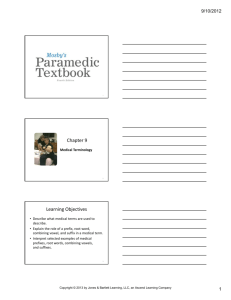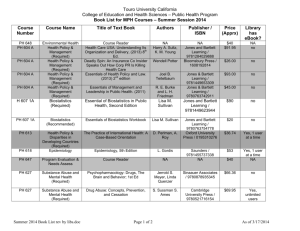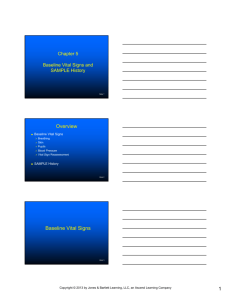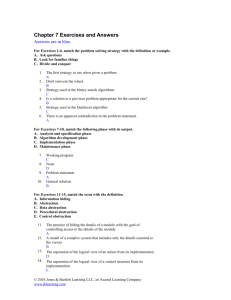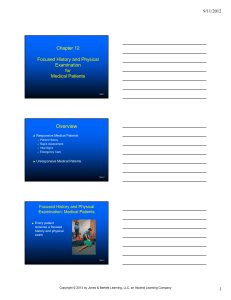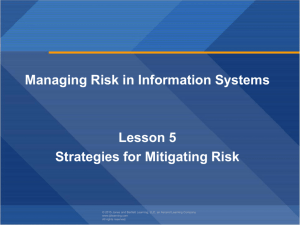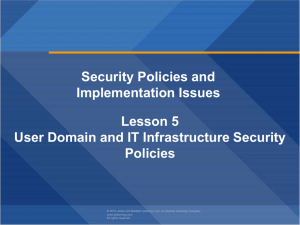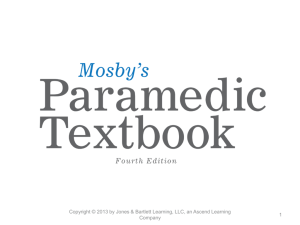Chapter 21 Learning Objectives
advertisement
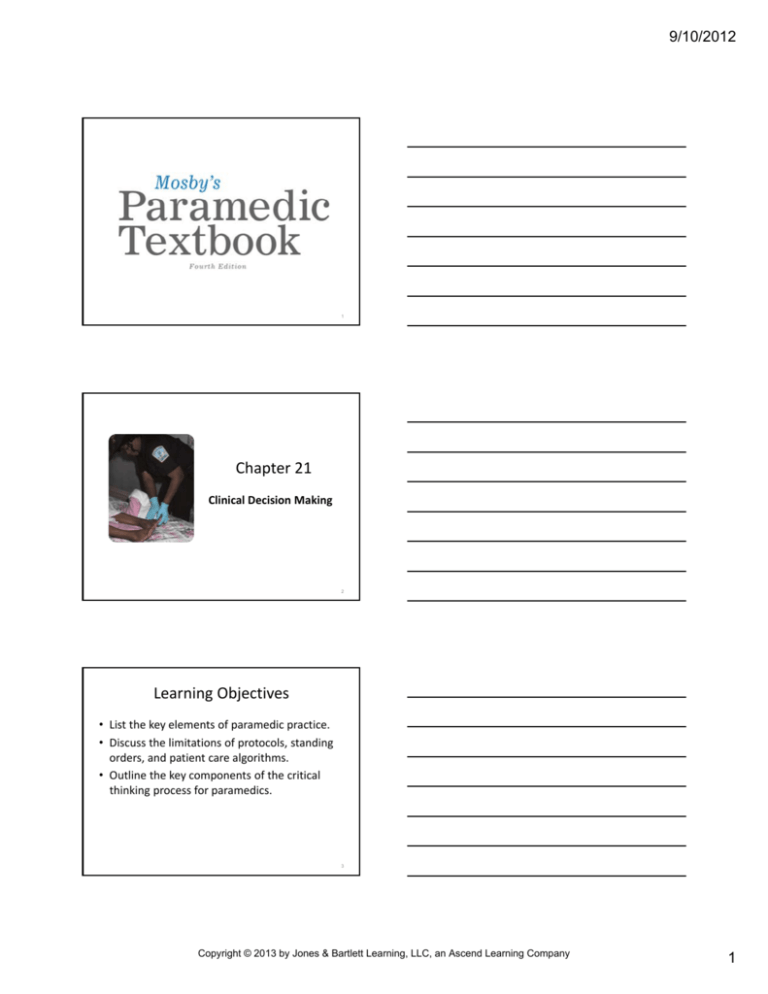
9/10/2012 1 Chapter 21 Clinical Decision Making 2 Learning Objectives • List the key elements of paramedic practice. • Discuss the limitations of protocols, standing orders, and patient care algorithms. • Outline the key components of the critical thinking process for paramedics. 3 Copyright © 2013 by Jones & Bartlett Learning, LLC, an Ascend Learning Company 1 9/10/2012 Learning Objectives • Identify elements necessary for an effective critical thinking process. • Describe situations that may necessitate the use of the critical thinking process while delivering prehospital patient care. • Describe the six elements required for effective clinical decision making in the prehospital setting. 4 Prehospital Care Spectrum • Paramedic must have wide base of knowledge, skills – May be exposed to • Critical life threats • Potential life threats • Non‐life‐threatening situations 5 Prehospital Care Spectrum • Protocols, standing orders, patient care algorithms – Help promote standardized approach to patient care for “classic” presentations – Presentations clearly define, outline performance parameters – Standards have limitations • May not apply to nonspecific patient complaints that do not fit “model” • Do not speak to multiple disease etiologies or multiple treatment modalities • Promote linear thinking 6 Copyright © 2013 by Jones & Bartlett Learning, LLC, an Ascend Learning Company 2 9/10/2012 Critical Thinking Process • Specific aspects of stages, sequences – Linked with critical thinking process – Concept formation – Data interpretation – Application of principle – Evaluation – Reflection on action 7 8 Concept Formation • All elements gathered to form general impression of patient – Scene assessment • Mechanism of injury • Social setting – – – – – Chief complaint Patient history Patient affect Initial assessment and physical examination Diagnostic tests 9 Copyright © 2013 by Jones & Bartlett Learning, LLC, an Ascend Learning Company 3 9/10/2012 What effect would inaccurate, incomplete, or incorrect concept formation have on your critical thinking process during patient care? How can you enhance your concept formation skills while in your paramedic program? 10 Date Interpretation • Helps form working diagnosis – Working phase of patient care • Quality rests on paramedic’s knowledge – Anatomy, physiology – Pathophysiology – Intuition – Previous experiences 11 Date Interpretation • Attempt to obtain complete picture of patient’s situation – Success greatly affected by paramedic’s attitude – Also affected by way encounter proceeds – May have to condense and convey data to on‐line physician who can help determine appropriate actions 12 Copyright © 2013 by Jones & Bartlett Learning, LLC, an Ascend Learning Company 4 9/10/2012 Application of Principle • Based on paramedic’s conceptual understanding of situation – Interpretation of data gathered from patient • Once field impression is made, working diagnosis is established – Treatment initiated through protocols, standing orders 13 Evaluation • Requires ongoing assessment of patient’s response to care provided – Reassessment of patient (ongoing assessment) – Reflection of action (effectiveness of intervention) – Revision of field impression (change in working diagnosis) – Review of appropriateness of protocol, standing orders, or direct orders – Revision of treatment or intervention as needed 14 Reflection of Action • Happens after event – Call evaluated for improvement in similar future responses – Provides paramedics with avenue to add/alter their experience base – Reinforces your data interpretation skills – Adds to student’s experience base 15 Copyright © 2013 by Jones & Bartlett Learning, LLC, an Ascend Learning Company 5 9/10/2012 Critical Thinking Fundamental Elements • Elements include knowledge, ability to – Focus on specific and multiple elements of data at same time – Gather, organize data and form concepts – Identify, deal with medical ambiguity • Patients who do not “fit” model 16 Critical Thinking Fundamental Elements • Elements include knowledge, ability to – Differentiate between relevant, irrelevant data – Analyze, compare similar situations from past experience – Recall cases in which working diagnosis was wrong – Articulate decision‐making reasoning, construct arguments to support/discount decision 17 Assessment‐Based Patient Management • Huge responsibility on paramedic – Must have systematic means of analyzing patient’s problems • Determine how to solve them • Carry out plan of action • Evaluate treatment effectiveness – Success depends on integration • Interpersonal skills • Scientific knowledge • Physical activities (skills) 18 Copyright © 2013 by Jones & Bartlett Learning, LLC, an Ascend Learning Company 6 9/10/2012 Patient Crisis Severity Spectrum • EMS set into action daily for many reasons – Few prehospital calls present true life threats – Minor medical, trauma events call for little critical thinking – Patients with clear life threats pose limited critical thinking challenges • Often fit “model” for standardized treatment – Some fall in spectrum between minor and life‐ threatening events • Pose most critical thinking challenges • Patients with mild to moderate respiratory distress • Patients with diffuse abdominal pain 19 Thinking Under Pressure • Hormonal influences from fight‐or‐flight response – Positive and negative effects on critical decision making – May offer greater visual acuity • Auditory keenness • Improved reflexes • Muscle strength 20 Do you think you can improve your performance under pressure by practicing imaginary critical situations in your head? Why or why not? 21 Copyright © 2013 by Jones & Bartlett Learning, LLC, an Ascend Learning Company 7 9/10/2012 Thinking Under Pressure • Hormonal influences from fight‐or‐flight response – Can be positive when critical decisions must be made, acted on – Negative aspects may reduce critical thinking skills • Can result from decrease in concentration, assessment ability 22 Thinking Under Pressure • Hormonal influences from fight‐or‐flight response – Key to strong performance under pressure is mental conditioning • Results in “instinctive performance,” “automatic responses” for technical procedures 23 Mental Checklist • Mental conditioning checklist takes practice – Stop and think – Scan situation – Decide and act – Maintain clear, effective control – Regularly, continually reevaluate patient 24 Copyright © 2013 by Jones & Bartlett Learning, LLC, an Ascend Learning Company 8 9/10/2012 Mental Checklist • Practicing when under pressure results in behavior that improve clinical decision making – Staying calm – Assuming plan for worst case (erring on side of patient) – Maintaining systematic assessment pattern – Learn to balance various styles of situation analysis (reflective vs. impulsive) • Data processing (divergent vs. convergent) • Decision making (anticipatory vs. reactive) 25 Mental Checklist • Situational analysis: reflective vs. impulsive – Avoid closing off pursuit of data too quickly to try to reach correct working diagnosis • Consider patient with lower right quadrant abdominal pain • Should not be assigned automatically working diagnosis of appendicitis • Impulsive decision because patient fits model • Take time to reflect on other conditions 26 Mental Checklist • Situational analysis: reflective vs. impulsive – Reflective example • When choosing IV catheter for elderly patient with small, fragile veins • Choose smaller‐gauge catheter that will provide venous access vs. larger‐bore catheter that might “blow the vein” 27 Copyright © 2013 by Jones & Bartlett Learning, LLC, an Ascend Learning Company 9 9/10/2012 Mental Checklist • Situational analysis: reflective vs. impulsive – Impulsive example • Paramedic immediately attempts IV access with large‐ bore catheter because it’s gauge she “always uses” 28 Mental Checklist • Data processing: divergent vs. convergent – Avoid trap of gathering only partial data • Similar to impulsive situation analysis • Known as convergent data processing – Convergent approach may be best in some cases • Giving standard drug dose to cardiac arrest patient – Convergent approach can hinder care in complex cases • Older patient with multiple complaints 29 Mental Checklist • Data processing: divergent vs. convergent – Divergent approach looks at all sides of case • Done before arriving at solution – Divergent data processing example • EMS training coordinator researches drug references • Consults with medical direction for dosing suggestions for new asthma drug carried on ambulance – Convergent data processing example • At an in‐house training session, paramedics are told “package insert says to give this amount…” 30 Copyright © 2013 by Jones & Bartlett Learning, LLC, an Ascend Learning Company 10 9/10/2012 Mental Checklist • Decision making: anticipatory vs. reactive – Anticipatory decision making • Process used by most health care professionals • Based on continuing data collection, evolution of patient’s condition – Reactive decision making • Decisions made only after problem occurs • Can have negative effects on patient care 31 Mental Checklist • Decision making: anticipatory vs. reactive – Anticipatory decision making example • Patient with large second‐degree burns being transported to burn center 30 miles away • Paramedic requests orders for IV morphine prior to leaving scene – Reactive decision making example • Paramedic caring for same patient waits until patient complains of pain before requesting morphine order 32 Six R’s • Put all components together required for effective clinical decision making into action • Read scene – Assess general environmental conditions – Evaluate immediate surroundings – Attempt to identify any mechanism of injury or clinical clues of illness 33 Copyright © 2013 by Jones & Bartlett Learning, LLC, an Ascend Learning Company 11 9/10/2012 34 Six Rs • Read patient – Observe patient’s level of consciousness and skin color – Note position of patient or obvious deformity or asymmetry – Talk to patient to determine chief complaint • This also identifies presence of worsening or preexisting condition 35 Six Rs • Read patient – Evaluate skin temperature, moisture – Assess pulse rate, strength, regularity – Auscultate lungs for upper or lower airway problems – Identify all life threats – Obtain accurate set of vital signs 36 Copyright © 2013 by Jones & Bartlett Learning, LLC, an Ascend Learning Company 12 9/10/2012 Six Rs • React – Manage all life threats when found – Determine most likely cause of life threat that fits patient’s initial presentation – If clearly defined and recognizable presentation of medical illness cannot be defined in priority patient, treatment should be based on presenting signs, symptoms 37 Six Rs • Reevaluate – Includes focused, detailed assessment – Analyze patient’s response to management, interventions • May lead to finding other problems • Other problems may not have been evident during primary assessment 38 Six Rs • Revise management plan – Findings may require revision • Revision will address patient needs more clearly – Patient conditions change, do not respond same way to identical treatment • Highlight importance of ongoing assessment and reassessment 39 Copyright © 2013 by Jones & Bartlett Learning, LLC, an Ascend Learning Company 13 9/10/2012 Six Rs • Review performance at run critique – Allows for improvements to be made for similar future calls – Interest and investment of paramedics in outcome of personal cases • Often strongest stimulus to change their practice patterns favorably – Enhances experience base • Leads to improvement of data interpretation skills 40 How do you think a very negative or punitive run critique would influence your ability to perform under a similar circumstance in the future? 41 Summary • The paramedic must be able to do several things at the same time – Gather, evaluate, and synthesize information – Develop and implement appropriate patient management plans – Apply judgment and exercise independent decision making – Think and work effectively under pressure 42 Copyright © 2013 by Jones & Bartlett Learning, LLC, an Ascend Learning Company 14 9/10/2012 Summary • Protocols, standing orders, and patient care algorithms have several limitations – May not apply to nonspecific patient complaints that do not fit model – Do not address multiple disease etiologies or multiple treatment plans – May promote linear thinking • Clinical decision rules may help determine risk when evaluating patients 43 Summary • The critical thinking process includes concept formation, data interpretation, application of principle, evaluation, and reflection on action • To reduce risk of errors in decision making, consciously ask yourself “is this the right decision?” – Be cautious in error‐prone situations – Recognize your biases and use care when making decisions in cases that involve those biases 44 Summary • For effective critical thinking, the paramedic must have a solid knowledge base – Must be able to deal with large amount of data all at once – Must be able to organize that data, deal with ambiguity, and relate the situation to similar past experience – Must be able to reason and construct arguments to support or discount decision 45 Copyright © 2013 by Jones & Bartlett Learning, LLC, an Ascend Learning Company 15 9/10/2012 Summary • When using assessment‐based patient management, the paramedic must analyze a patient’s problems, determine how to solve them, carry out a plan of action, and evaluate its effectiveness • Effective clinical decision making requires that the paramedic read patient and scene – Must be able to react, reevaluate, and revise management plan – Must be able to review performance at run critique 46 Questions? 47 Copyright © 2013 by Jones & Bartlett Learning, LLC, an Ascend Learning Company 16
